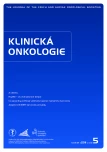Neuroendoscopic Biopsy of a Brain Tumor
Authors:
Z. Novák; J. Chrastina; I. Říha; R. Jančálek
Authors‘ workplace:
Neurochirurgická klinika, LF MU a FN u sv. Anny v Brně
Published in:
Klin Onkol 2011; 24(5): 348-355
Category:
Original Articles
Overview
Backrounds:
Neuroendoscopic biopsy is one of the techniques that can be used for histological verification of a suspected brain tumor. The use of neuroendoscopy is particularly useful for cystic tumors and para- and intraventricular brain tumors that are risky for stereotactic biopsy. The technique of navigated neuroendoscopy enables biopsy sampling under visual control, haemostasis of biopsy site and treatment of cerebrospinal fluid pathways obstruction.
Patients and Methods:
Neuroendoscopic technique was used for biopsy in one patient with a solid brain tumor. 23 patients (12 males, mean age 49.7 years, range 21–75 years and 11 females, mean age 59.1 years, range 22–76 years) with a suspected cystic brain tumor underwent neuroendoscopic biopsy. Suspected intra- or paraventricular brain tumor presented indication for neuroendoscopic biopsy in 36 patients (20 males, mean age 43.9 years, range 6–80 years and 16 females, mean age 46.2 years, range 11–78 years).
Results:
High grade glioma was most frequently diagnosed in patients with cystic brain tumors, followed by low grade gliomas and metastatic tumors. Diagnostic sample was obtained from all patients. Tumor resection was performed in 7 patients with a cystic tumor after neuroendoscopic biopsy and histological findings were identical in 70.1% of them. Similarly, high grade glioma was most frequently diagnosed in patients with intra or paraventricular tumors, followed by tumors originating from pineal region tissues. Diagnostic sample was obtained from 94.3% of patients. Tumor resection was performed in 5 patients after neuroendoscopic biopsy and histological findings of the resected tissue was identical with neuroendoscopic biopsy in 4 of them (80%).
Conclusions:
Neuroendoscopy is a safe biopsy technique for a subset of patients who are high risk for the use of stereotactic biopsy, with comparable results. Neuroendoscopy also provides for cerebrospinal fluid circulation obstruction treatment. The use of neuronavigation or stereotactic planning is particularly useful for the planning of an optimal surgical approach, helps to maintain anatomical orientation in distorted anatomy and facilitates haemostasis in case of intraoperative bleeding.
Key words:
brain tumor – neuroendoscopy – stereotaxy – biopsy
Supported by VZ MŠMT 0021622404 and MZCR IGA NS 10411-3.
The authors declare they have no potential conflicts of interest concerning drugs, products, or services used in the study.
The Editorial Board declares that the manuscript met the ICMJE “uniform requirements” for biomedical papers.
Submitted:
11. 3. 2011
Accepted:
20. 6. 2011
Sources
1. Novák Z, Chrastina J, Říha I. Atlas of neuroendoscopic surgery. Praha: Maxdorf Jesenius 2007.
2. Novák Z, Chrastina J. Neuroendoskopie – historické poznámky. Endoskopie 2006; 15(3): 48–53.
3. Fukushima T, Ishijima B, Hirakawa K et al. Ventriculofiberscope: new technique for endoscopic diagnosis and operation. Technical note. J Neurosurg 1973; 38(2): 251–256.
4. Fukushima T. Endoscopic biopsy of intraventricular tumors with the use of a ventriculofiberscope. Neurosurgery 1978; 2(2): 110–113.
5. Kreth FW, Muacevic A, Medele R et al. The risk of haemorrhage after image guided stereotactic biopsy of intra-axial brain tumours – a prospective study. Acta Neurochir (Wien) 2001; 143(6): 539–545.
6. Nakano T, Ohkuma H, Asano K et al. Endoscopic treatment for deep-seated or multiple intraparenchymal tumors: technical note. Minim Invasive Neurosurg 2009; 52(1): 49–52.
7. Akai T, Shiraga S, Sasagawa Y et al. Intra-parenchymal tumor biopsy using neuroendoscopy with navigation. Minim Invasive Neurosurg 2008; 51(2): 83–86.
8. Ritz R, Feigl GC, Schuhmann MU et al. Use of 5-ALA fluorescence guided endoscopic biopsy of a deep seated primary malignant brain tumor. J Neurosurg 2010; 114(5): 1410–1413.
9. Tirakotai W, Schulte DM, Bauer BL et al. Neuroendoscopic surgery of intracranial cysts in adults. Childs Nerv Syst 2004; 20(11–12): 842–851.
10. Novak Z. Endoscopic cure of cerebellar hemangioblastoma. Bratisl Lek Listy 2004; 105(1): 8–10.
11. Di X. Multiple brain tumor nodule resections under direct visualization of a neuronavigated endoscope. Minim Invasive Neurosurg 2007; 50(4): 227–232.
12. Naftel RP, Shannon CN, Reed GT et al. Small ventricle neuroendoscopy for pediatric brain tumors management. J Neurosurg Pediatr 2011; 7(1): 104–110.
13. Souweidane MM. Endoscopic surgery for intraventricular brain tumors in patients without hydrocephalus. Neurosurgery 2005; 57 (Suppl 4): 312–318.
14. Tirakotai W, Hellwig D, Bertalanffy H et al. The role of neuroendoscopy in the management of solid or solid-cystic intra- and periventricular tumors. Childs Nerv Syst 2007; 23(6): 653–658.
15. Luther N, Cohen A, Souweidane MM. Hemorrhagic sequelae from intracranial neuroendoscopic procedures for intraventricular tumors. Neurosurg Focus 2005; 19(1): E9.
16. Lakomý R, Burkoň P, Burkoňová D et al. Nové možnosti léčby glioblastoma multiforme. Klin Onkol 2010; 23(6): 381–387.
17. Luther N, Stetler WR Jr, Dunkel IJ et al. Subarachnoid dissemination of intraventricular tumors following simultaneous endoscopic biopsy and third ventriculostomy. J Neurosurg Pediatr 2010; 5(1): 61–67.
18. Jurga L, Malý M. Úskalia kombinovanej rádio a chemoterapie maligných gliómov. Klin Onkol 2006; 19(6): 317–321.
19. Macarthur DC, Buxton N, Punt J et al. The role of neuroendoscopy in the management of brain tumours. Br J Neurosurg 2002; 16(5): 465–470.
20. Fiorindi A, Longatti P. A restricted neuroendoscopic approach for pathological diagnosis of intraventricular and paraventricular tumours. Acta Neurochir (Wien) 2008; 150(12): 1235–1239.
21. Ahn ES, Goumnerova L. Endoscopic biopsy of brain tumors in children: diagnostic success and utility in guiding treatment strategies. J Neurosurg Pediatr 2010; 5(3): 255–262.
22. Prat R, Galeano I. Endoscopic biopsy of foramen of Monro and third ventricle lesions guided by frameless neuronavigation: usefulness and limitations. Clin Neurol Neurosurg 2009; 111(7): 579–582.
Labels
Paediatric clinical oncology Surgery Clinical oncologyArticle was published in
Clinical Oncology

2011 Issue 5
Most read in this issue
- Partial Regression of CNS Lesions of Erdheim-Chester Disease after Treatment with 2-chlorodeoxadenosine and Their Full Remission Following Treatment with Lenalidomide
- Neuroendoscopic Biopsy of a Brain Tumor
- Secondary Angiosarcomas after Conservation Treatment for Breast Cancers
- Neoadjuvant Chemoradiotherapy of Rectal Carcinoma with Bevacizumab
